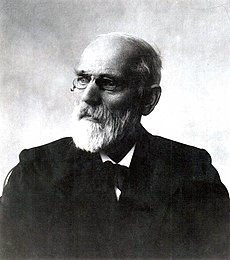Our website is made possible by displaying online advertisements to our visitors.
Please consider supporting us by disabling your ad blocker.
Johannes Diderik van der Waals
Johannes van der Waals | |
|---|---|
 | |
| Born | 23 November 1837 Leiden, Netherlands |
| Died | 8 March 1923 (aged 85) Amsterdam, Netherlands |
| Alma mater | University of Leiden |
| Known for | Laying the foundations for modern molecular physics (molecular theory) Originating modern theory of intermolecular forces Law of corresponding states Real gas law Van der Waals forces Van der Waals equation of state Van der Waals radius Van der Waals surface Van der Waals molecule |
| Awards | Nobel Prize for Physics (1910) |
| Scientific career | |
| Fields | Theoretical physics, thermodynamics |
| Institutions | University of Amsterdam |
| Doctoral advisor | Pieter Rijke |
| Doctoral students | Diederik Korteweg Willem Hendrik Keesom |
| Influences | Rudolf Clausius Ludwig Boltzmann Josiah Willard Gibbs Thomas Andrews |
| Influenced | Heike Kamerlingh Onnes Willem Hendrik Keesom Peter Debye Zygmunt Florenty Wróblewski James Dewar Fritz London John Shipley Rowlinson Modern molecular science (including molecular physics and molecular dynamics) Cryogenics |
Johannes Diderik van der Waals (Dutch pronunciation: [joːˈɦɑnəz ˈdidərɪk fɑn dər ˈʋaːls] (![]() listen)[note 1]; 23 November 1837 – 8 March 1923) was a Dutch theoretical physicist and thermodynamicist. He became famous for his pioneering work on the equation of state for gases and liquids. Van der Waals started his career as a school teacher. In 1877, he became the first physics professor of the University of Amsterdam. Van der Waals won the 1910 Nobel Prize in physics for his work on the equation of state for gases and liquids.[1]
listen)[note 1]; 23 November 1837 – 8 March 1923) was a Dutch theoretical physicist and thermodynamicist. He became famous for his pioneering work on the equation of state for gases and liquids. Van der Waals started his career as a school teacher. In 1877, he became the first physics professor of the University of Amsterdam. Van der Waals won the 1910 Nobel Prize in physics for his work on the equation of state for gases and liquids.[1]
Cite error: There are <ref group=note> tags on this page, but the references will not show without a {{reflist|group=note}} template (see the help page).
- ↑ "The Nobel Prize in Physics 1910". Nobel Foundation. Retrieved 2008-10-09.
Previous Page Next Page
Johannes Diderik van der Waals AF Johannes Diderik van der Waals AN يوهانس ديديريك فان دير فالس Arabic يوهانس ديديريك فان دير فالس ARZ Johannes van der Waals AST Johannes van der Waals AY Yan Van-der-Vaals AZ یوهان دیدریک وان در والس AZB Ян Дыдэрык Ван-дэр-Ваальс BE Ян Дыдэрык Ван-дэр-Ваальс BE-X-OLD


